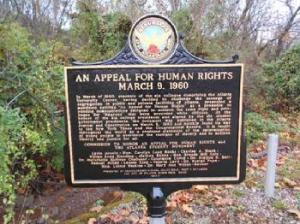Atlanta Student Movement Historical Trail to be Unveiled with Interactive Markers
 APN) ATLANTA — Fifteen historical interactive markers are currently being erected around the Atlanta University Center to memorialize the student movement that sparked the Civil Rights Movement in Atlanta back in 1960.
APN) ATLANTA — Fifteen historical interactive markers are currently being erected around the Atlanta University Center to memorialize the student movement that sparked the Civil Rights Movement in Atlanta back in 1960.
At unveiling is to take place on tomorrow, Saturday, November 01, 2014.
On June 07, 2010, a Commission was created to identify locations where these historical actions took place, and erect markers to memorialize different actions that took place in the 1960’s student movement in Atlanta.
The first phase called the Atlanta Student Movement Historical Trail will begin at the corner of James P. Brawley Drive and Atlanta Student Movement Boulevard.
Fifteen markers will be erected with the majority placed around the Atlanta University Center and some downtown around the old Rich’s building.
Atlanta City Councilman Michael Julian Bond (Post 1 At-Large) tells Atlanta Progressive news that the markers will chronicle the Atlanta Student Movement between 1960 and 1965 with text of what happened at that spot.
The markers will be interactive with QR codes that a person can scan with a smartphone or mobile device and will take you to a web page with more information about the history. The web pages will also have videos of individuals who participated in the event at that site.
“You can go to where the historical action took place and interact with the people who participated in the action and actually walk the march route,” Bond told APN.
“We hope to eventually be able to highlight Atlanta’s history or a portion of Atlanta’s history in a similar fashion in different parts of the city… Atlanta has a rich legacy and we need to promote it,” Bond said.
The student sit-in movement to integrated restaurants began in February 1960 in Greensboro, North Carolina, when four Black college students sat down at a Woolworth’s lunch counter.
The idea quickly spread to the Atlanta University Center (AUC), which is comprised of Clark College, Interdenominational Theological Center, Morehouse College, Morris Brown College, and Spelman College.
AUC students Lonnie King, Julian Bond, Carolyn Long, Joseph Pierce, Marian Wright, and others formed a committee to advocate for an end to racial segregation through non-violent means.
Students from AUC, who took an oath of non-violence, began the first sit-in on March 15, 1960.
At 11:00 a.m., students from AUC sat down at restaurants and cafeterias located in tax-supported institutions: Greyhound Bus Station, Trailways Bus Station, Atlanta City Hall, Fulton County, and the Georgia State Capitol. 77 students were arrested that day.
Hundreds of students conducted marches, picketing, and boycotts, and staged sit-ins throughout Atlanta, with a large number of arrests over several years.
“One of the places where I was arrested was the Magnolia Room at Rich’s Department Store. It was the premier downtown eating place. We convinced Dr. Martin Luther King, Jr. to join us,” former Atlanta City Councilwoman Carolyn Long Banks, the first Black female member of the Council, told APN.
“I refused to leave the jail until Dr. King left. King convinced the jailer to let him walk with me and when we got to the exit, he pushed me out the door and it slammed shut. I turned around crying let me back in, let me back in,” Long Banks said.
By the end of 1960 the “Old Guard” of Black leaders finally joined the young student leaders to help fight the segregation battle.
Prominent members of the “Old Guard” were Dr. William Holmes Borders; Rev. Martin Luther King Sr.; Rev. Otis Moss Jr.; Dr. Samuel Williams; Rev. James Wilborn; Rev. B.J. Johnson Sr.; and Mr. John Wesley Dobbs.
The actions of those courageous AUC students grew into the Civil Rights Movement that eventually resulted in the desegregation of public and private facilities. Their actions changed the U.S. South and the nation.
In 1973, Rich’s Department Store, under a court order, hired thirteen candidates to be trained for managerial positions.
Ironically Carolyn Long Banks, who in 1960 went to jail integrating the Magnolia restaurant at Rich’s, was one of those candidates hired and two years later became Rich’s first Black buyer.
Bond shared the story of how Atlanta became the “city too busy to hate,” crediting Ivan Allen for that phrase.
Business leaders and political leaders got together and recognized that refusing to desegregate was not sustainable and was not good for business. They saw what was happening in Alabama and other places, and did not want Atlanta to follow that path of violence. The phrase “the city too busy to hate” comes out of that recognition.
Atlantans did not want to spend time trying to cling to their segregationist past but wanted to move forward and be about business, commerce, and progress.
Thanks to the Atlanta Student Movement, the City began to live up to its slogan, “A city too busy to hate.”
(END/2014)